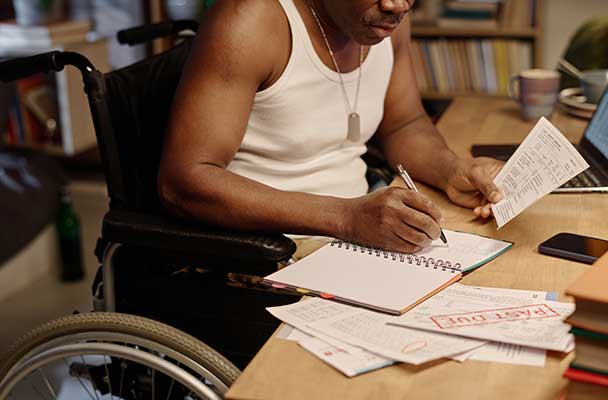
Disabled Veteran Debt Relief Programs 2026
If you’re a disabled veteran, you’ve already served and sacrificed more than most. There are disabled veteran debt relief programs in 2026 that are built to ease some of that weight. This guide helps you understand which ones apply to your situation, and how to make them work for you.
Disabled Veteran Debt Relief Programs in 2026
Here’s the quick rundown. We’ve listed programs by disability rating, income level, and debt type.
|
Program |
Disability Rating / Eligibility |
Income Threshold |
What Assistance Provides |
Time to Approval / Start |
Duration or Renewal |
|---|---|---|---|---|---|
|
VA Disability Compensation |
Any rating with service connection |
N/A |
Baseline protected income |
1–3 months (after claim approval; retroactive payments possible) |
Ongoing monthly, for life (subject to re-evaluation) |
|
VA Medical Debt Forgiveness |
Service-connected care, low income hardship |
Needs-based |
Forgives VA-issued medical debt |
60–90 days for application and review |
One-time forgiveness per application; can reapply if new debt |
|
Vocational Rehabilitation & Employment (VR&E) |
Typically 20%+ with employment barrier |
N/A |
Tuition, training, housing, supplies |
Application + counselor review (1–3 months) |
Program-based, up to 48 months of benefits |
|
Specially Adapted Housing (SAH) Grants |
Severe mobility-related disability |
N/A |
Funds to adapt or purchase housing |
3–6 months for approval and processing |
One-time grant, but some supplemental allowances may apply |
|
Emergency Financial Hardship Grants (DAV, VFW, state) |
Proof of service-connected disability + financial need |
Needs-based |
Direct financial relief for bills, rent, utilities |
Immediate to 30 days depending on organization |
One-time or short-term aid (often 1–3 months) |
|
Nonprofit Disabled Veteran Debt Assistance |
Typically 10%+ rating with proof of financial hardship (criteria vary by nonprofit) |
Needs-based |
Targeted medical or household debt payoff |
30–90 days depending on nonprofit review |
One-time relief; may offer follow-up support |
|
Student Loan Forgiveness (TPD Discharge) |
Total and permanent disability (100%) |
N/A |
Full federal student loan discharge |
3–6 months for application and processing |
Permanent discharge, applies once |
|
Credit Counseling (disability adjusted) |
Any rating |
Varies by income |
Budget help, creditor negotiations |
2–4 weeks to enroll and begin services |
Ongoing while enrolled; usually 6–36 months |
|
Bankruptcy Protections for Veterans |
Any rating |
Court-based |
VA disability checks protected from creditors |
Legal filing process, typically 2–4 months |
Duration of bankruptcy plan (Chapter 7: months; Chapter 13: 3–5 years) |
VA Disability Compensation
This is your baseline. If you have a service-connected condition, you receive monthly tax-free pay from the VA. Creditors cannot take it. That check is protected. Use it as your steady ground when working debt relief or negotiating with lenders.
Application and Duration: You apply through a VA disability claim, which may take one to three months or longer for approval. Once granted, benefits are ongoing for life and may include retroactive back pay.
Best for: Any veteran with a service-connected disability who needs steady, long-term income protection.
VA Medical Debt Forgiveness
If you owe the VA for medical care, apply for hardship relief. They can forgive the balance if your income is limited. This only applies to VA-issued bills, but if you qualify, it takes the weight off.
Application and Duration: You must submit a financial hardship application and provide income documentation. Reviews typically take 60–90 days. Forgiveness is one-time per application but can be reapplied for if new VA debt appears.
Best for: Veterans with low income who owe medical debt directly to the VA.
Vocational Rehabilitation & Employment (VR&E)
Chapter 31 helps veterans who cannot return to their old jobs. It pays for school, training, supplies, and sometimes housing. This keeps you from piling on student loan or credit card debt while retraining.
Think of VR&E as an indirect debt relief tool. If you’re eligible:
- It pays for school, training, books, and supplies.
- It covers living stipends while enrolled.
- By reducing out-of-pocket costs, it cuts down future debt before it piles up.
Application and Duration: You apply through the VA and meet with a vocational counselor. It can take one to three months to get started. Benefits may last up to 48 months depending on your program.
Best for: Veterans with a 20%+ disability rating who need retraining to start a new career.
Specially Adapted Housing (SAH) Grants
If your disability limits your ability to move around your home, SAH can cover the cost of ramps, wider doors, or a new bathroom layout. It can also help with buying a more suitable home. You get one shot at this grant, so plan it carefully.
Application and Duration: You apply through the VA. Approval usually takes three to six months. The grant is one-time, though there are some smaller supplemental allowances if your needs change.
Best for: Veterans with severe mobility-related disabilities who need to make their home safe and accessible.
Emergency Financial Hardship Grants (DAV, VFW, state programs)
When bills stack up and you are at risk of losing housing or utilities, service organizations like DAV and VFW can step in. These grants are quick to process and cover basic living expenses.
Application and Duration: You must show proof of service and financial hardship. Approval can take a few days to 30 days depending on the organization. Assistance is short-term, usually covering one to three months of bills.
Best for: Veterans facing immediate financial crisis who need quick relief.
Nonprofit Disabled Veteran Debt Assistance
Some nonprofits erase veteran medical debt or provide grants for daily costs. Others will step in to negotiate with creditors. Results vary, but they can reduce debts the VA does not cover.
Application and Duration: Most nonprofits require at least a 10% disability rating and proof of financial hardship. Reviews can take 30–90 days. Relief is usually one-time, though some nonprofits provide follow-up support.
Best for: Disabled veterans struggling with non-VA debt such as medical, utility, or household bills.
Student Loan Forgiveness (Total & Permanent Disability Discharge)
Veterans with a 100% Permanent and Total rating qualify for full federal student loan discharge. It takes a few months to process, but once approved, the loans are gone.
Application and Duration: You apply with documentation of your P&T rating or medical certification. Processing takes three to six months. The discharge is permanent and applies once.
Best for: Veterans with federal student loans and a Permanent and Total disability rating.
Credit Counseling (Disability Adjusted)
Credit counseling agencies help you build a budget and negotiate lower payments with creditors. Some adjust fees for disabled veterans. It will not erase debt, but it can give structure and stop collection calls.
Application and Duration: Enrollment usually takes two to four weeks. Programs last six to 36 months depending on your debt load.
Best for: Veterans who need structure and steady support to reduce debt without filing bankruptcy.
Bankruptcy Protections for Veterans
Bankruptcy is the last resort, but VA disability checks remain protected. Creditors cannot take them in court. If you file, your compensation still comes through, giving you a lifeline.
Application and Duration: Filing for bankruptcy is a legal process that takes two to four months. Protection lasts the length of the bankruptcy—months for Chapter 7, or three to five years for Chapter 13.
Best for: Veterans with overwhelming debt who need a legal reset while keeping VA disability income protected.
Understanding Which Program is Right for You
Every veteran’s situation is different. The programs you qualify for depend on your disability rating, your income, and the type of debt you’re dealing with. We use two visuals here: one that points you to the right program based on your circumstances and another that shows how much pay your rating brings in.
Qualification Matrix by Disability Rating %
|
Program |
0–40% |
50–90% |
100% |
|---|---|---|---|
|
VA Disability Compensation |
✔ |
✔ |
✔ |
|
VA Medical Debt Forgiveness |
— (Specific hardship) |
— (Specific hardship) |
✔ |
|
VR&E (Voc Rehab) |
— (Potentially) |
✔ |
✔ |
|
SAH Housing Grant |
✘ |
— (Partially) |
✔ |
|
Emergency Hardship Grants |
✔ |
✔ |
✔ |
|
Nonprofit Assistance |
✔ |
✔ |
✔ |
|
TPD Student Loan Forgiveness |
✘ |
✘ |
✔ |
|
Credit Counseling |
✔ |
✔ |
✔ |
|
Bankruptcy Protections |
✔ |
✔ |
✔ |
VA Disability Compensation by Rating (2026 Estimate with 2.5% COLA)
Disability Compensation as an Income Source
VA disability compensation is protected income. Creditors can’t garnish it, and it doesn’t vanish in bankruptcy court. That means when you sit down and engage with one of the various disabled veteran debt relief programs in 2026, you’ve got leverage.
- Protected from garnishment: Your VA disability income can’t be touched by most creditors.
- Counts toward program thresholds: Some relief programs use total household income, so compensation can tip the scales, but it also proves a financial hardship when expenses outrun it.
Medical Debt Considerations
Medical debt is the landmine many disabled veterans step on. If it happens to you, it isn’t because you are a failure or made a mistake; it’s completely normal. But that doesn’t make it any less burdensome. Here’s what to know:
- Service-connected care: VA medical debt can often be forgiven if you prove hardship.
- Non-service-connected care: Private bills are tougher, but nonprofits and hospital forgiveness programs may help.
- Copays & insurance gaps: Even small gaps add up fast. Document them and explore hardship relief through VA and state programs.
FAQs: Disabled Veteran Debt Relief Programs in 2026
|
Question |
Answer |
|---|---|
|
Does my disability rating affect how creditors negotiate with me? |
Yes. The higher your rating, the stronger your case when pushing for reduced payments or hardship status. |
|
Can VA disability compensation be used to qualify for income-based programs? |
Sometimes. Some programs count it, others don’t. Always check the fine print before you apply. |
|
Are there debt relief programs that help with non-service-connected medical bills? |
Yes. Nonprofits like RIP Medical Debt and some hospitals run hardship programs that target those balances. |
|
Do state veteran programs offer debt relief separate from the VA? |
Many do. State veteran offices often run emergency funds or grant programs separate from the VA. |
|
Is credit counseling safe for disabled veterans? |
Yes, if you use an accredited nonprofit. Skip any outfit asking for upfront fees or promising “instant fixes.” |
|
Can I combine VA benefits with nonprofit or state programs? |
Yes. Veterans often stack VA protections, nonprofit help, and state aid to cover different needs. |
|
Will applying for debt relief affect my VA disability rating? |
No. These programs don’t affect your rating or your monthly check. |






